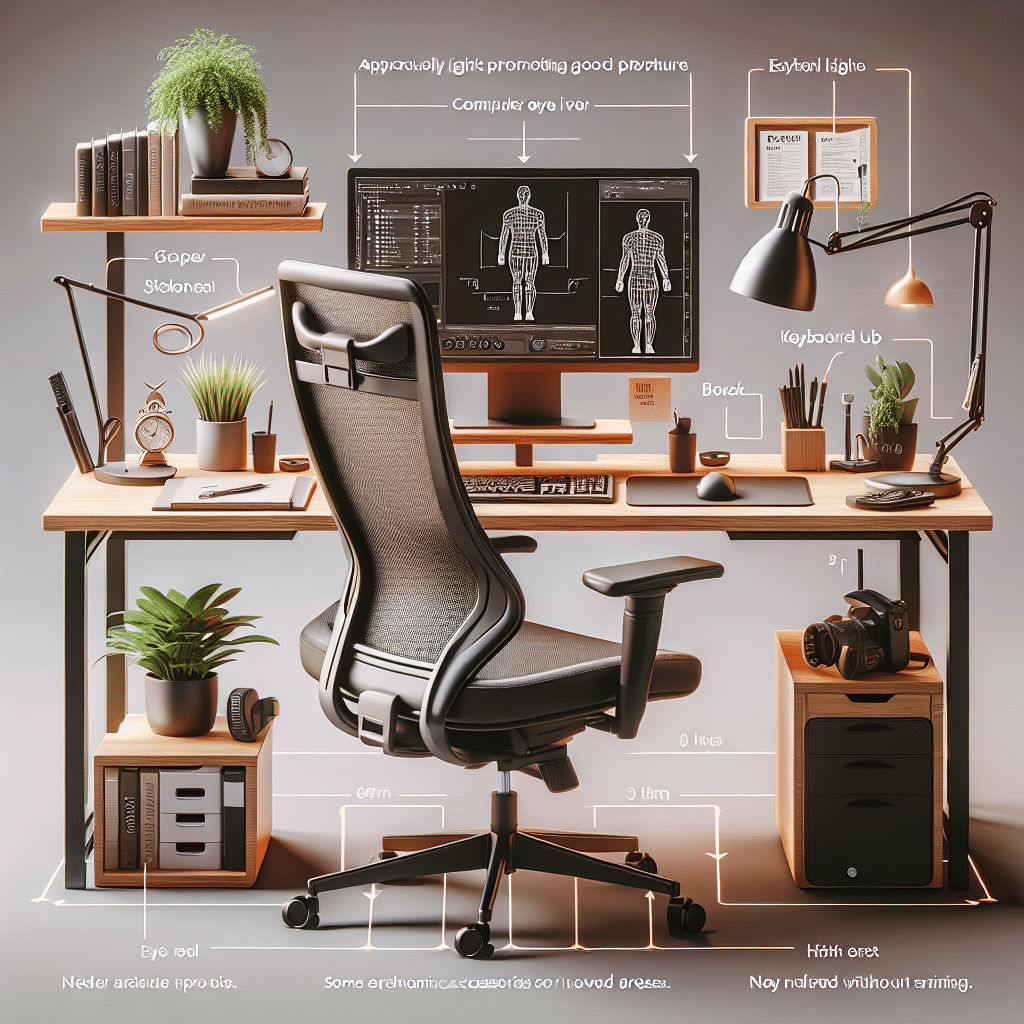Desk Organization Tips for Promoting Better Posture and Ergonomics
1. Assess Your Workspace Layout
Before implementing any desk organization, evaluate your current workspace setup. Start by determining if your desk height is appropriate for your chair. Your elbows should be at a 90-degree angle when typing, with your wrists straight. A desk that is too high or too low can contribute to poor posture.
2. Choose the Right Chair
Selecting a chair that provides proper support is crucial. Look for an ergonomic chair that has adjustable height, lumbar support, and a seat depth that fits your body. Your feet should rest flat on the ground, with your knees slightly lower than your hips.
3. Monitor Placement
Position your computer monitor directly in front of you, about an arm’s length away. The top of the screen should be at or just below eye level. This arrangement minimizes neck strain and promotes a natural head position. To ensure alignment, consider using monitor risers if your screen is too low.
4. Keyboard and Mouse Positioning
Your keyboard and mouse should be on the same level and positioned close enough to prevent reaching. Your wrists should remain straight and your hands should float above the keyboard. Investing in an ergonomic keyboard and mouse can provide added comfort and help maintain proper wrist posture.
5. Utilize Cable Management Solutions
Cluttered cables can lead to distractions, but they can also create physical barriers to maintaining good posture. Use cable management trays, clips, and sleeves to organize cords and keep your workspace tidy. A clean workspace enhances focus and reduces the inclination to hunch over for better access to cables.
6. Incorporate a Document Holder
If you frequently refer to printed documents while typing, consider using a document holder. Position it at eye level, next to your monitor to minimize neck movement and encourage proper alignment. This reduces the tendency to twist or lean away from the screen while working.
7. Drawer Organization
Keep your desk clutter-free by organizing drawers smartly. Use drawer dividers to separate office supplies, and place frequently used items within easy reach. High-quality organizers can help maintain a tidy space, reducing distractions that can lead to poor posture as you reach or lean for tools.
8. Use Ergonomic Accessories
Embracing ergonomic accessories can greatly enhance comfort. Tools such as wrist rests, footrests, and lumbar pillows can provide additional support. A footrest can elevate your feet, ensuring alignment and encouraging better circulation, while wrist rests help maintain straight wrists during keyboard use.
9. Adjust Lighting
Proper lighting is an often-overlooked aspect of desk organization that can influence posture. Ensure that your workspace is well-lit without causing glare on your computer screen. Adjustable desk lamps can help reduce eye strain, encouraging you to sit more comfortably and maintain a proper posture.
10. Standing Desks and Adjustable Options
Consider incorporating a standing desk or desk converter into your workspace for varied working positions. Alternating between sitting and standing can reduce the risks associated with prolonged sitting. Ensure that you adjust your monitor and keyboard to maintain ergonomics regardless of your desk height.
11. Ergonomic Footwear
If your home office setup allows for more casual clothing, invest in ergonomic footwear. Standing for extended periods, even at a standing desk, can lead to foot and back discomfort. Supportive shoes can help maintain proper alignment throughout your body.
12. Maintain a Clutter-free Desk Surface
A clean desk promotes not only productivity but also good posture by limiting distractions. Aim to keep only essential items at arm’s reach, such as utensils, a notepad, or a digital assistant. This minimizes the tendency to lean or twist awkwardly while searching for items.
13. Regular Breaks and Movements
Incorporate regular breaks into your work routine. The 20-20-20 rule recommends that for every 20 minutes of screen time, you look at something 20 feet away for 20 seconds. Use breaks to stretch or walk around, which not only benefits your posture but also enhances overall well-being.
14. Mindful Sitting Techniques
Practice mindful sitting by regularly checking your posture. Your back should be straight, shoulders relaxed, and feet flat. Refrain from crossing your legs, which can lead to imbalances in muscle tension. Remind yourself to readjust your seating posture throughout the workday.
15. Hydration Station
Keeping a water bottle on your desk can encourage you to stay hydrated, which indirectly supports posture by promoting better concentration and energy levels. Staying hydrated can also prevent fatigue, reducing the need for awkward stretching or contorted postures due to strain.
16. Use Soft Surfaces
When applicable, placing soft surfaces like anti-fatigue mats under your feet at a standing desk can reduce discomfort. These mats encourage subtle movement in your feet and legs, helping to improve circulation and keeping your muscles engaged.
17. Create a Personal Touch
Personalize your workspace with items that inspire you, such as plants or motivational quotes. This not only enhances your mood but also encourages you to maintain an upright posture as you work thoughtfully in a space that reflects your personality.
18. Rate Your Ergonomics
Finally, periodically rate your workspace and ergonomics setup. Assess the comfort level of your chair, desk height, and monitor placement. Adjust any components that feel uncomfortable or contribute to strain. This proactive approach ensures that you are attentive to changes in your workspace needs over time.
19. Use a Timer for Task Management
Utilizing a timer can help structure your work sessions, prompting regular breaks and stretching. A clear schedule can alleviate the urge to slouch over your computer as you attempt to finish tasks rapidly. With a balanced approach to timing, you establish a healthier work rhythm.
20. Seek Professional Ergonomic Assessments
For those working from home or in an unconventional setup, consider scheduling a professional ergonomic assessment. An expert can provide tailored recommendations specific to your workspace and workstyle, ensuring that your setup promotes optimal posture and well-being.
